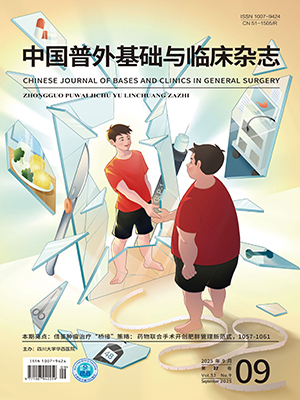| 1. |
Bray F, Ferlay J, Soerjomataram I, et al. Global cancer statistics 2018: GLOBOCAN estimates of incidence and mortality worldwide for 36 cancers in 185 countries. CA Cancer J Clin, 2018, 68(6): 394-424.
|
| 2. |
郑荣寿, 孙可欣, 张思维, 等. 2015 年中国恶性肿瘤流行情况分析. 中华肿瘤杂志, 2019, 41(1): 19-28.
|
| 3. |
Tufano RP, Noureldine SI, Angelos P. Incidental thyroid nodules and thyroid cancer: considerations before determining management. JAMA Otolaryngol Head Neck Surg, 2015, 141(6): 566-572.
|
| 4. |
肖海鹏, 洪澍彬, 喻爽. 甲状腺癌流行趋势及其影响因素. 内科理论与实践, 2013, 8(6): 383-386, 387.
|
| 5. |
中华医学会内分泌学分会, 中华医学会外科学分会内分泌学组, 中国抗癌协会头颈肿瘤专业委员会, 等. 甲状腺结节和分化型甲状腺癌诊治指南. 中华核医学与分子影像杂志, 2013, 33(2): 96-115.
|
| 6. |
Robbins KT, Clayman G, Levine PA, et al. Neck dissection classification update: revisions proposed by the American Head and Neck Society and the American Academy of Otolaryngology-Head and Neck Surgery. Arch Otolaryngol Head Neck Surg, 2002, 128(7): 751-758.
|
| 7. |
Lepoutre-Lussey C, Maddah D, Golmard JL, et al. Post-operative neck ultrasound and risk stratification in differentiated thyroid cancer patients with initial lymph node involvement. Eur J Endocrinol, 2014, 170(6): 837-846.
|
| 8. |
邵堂雷, 王振乾, 蒋晓, 等. 甲状腺再次手术中喉返神经保护研究(附 163 例分析). 中国实用外科杂志, 2015, 35(6): 656-658.
|
| 9. |
Raffaelli M, De Crea C, Sessa L, et al. Prospective evaluation of total thyroidectomy versus ipsilateral versus bilateral central neck dissection in patients with clinically node-negative papillary thyroid carcinoma. Surgery, 2012, 152(6): 957-964.
|
| 10. |
Ito Y, Tomoda C, Uruno T, et al. Clinical significance of metastasis to the central compartment from papillary microcarcinoma of the thyroid. World J Surg, 2006, 30(1): 91-99.
|
| 11. |
安祥, 余丹, 李兵. 预防性中央区淋巴结清扫对甲状腺微小乳头状癌患者预后影响的Meta分析. 临床耳鼻咽喉头颈外科杂志, 2019, 33(2): 138-142.
|
| 12. |
刘文, 程若川. 甲状腺乳头状癌中央区淋巴结转移的预测因素. 中国普外基础与临床杂志, 2018, 25(1): 99-103.
|
| 13. |
Amin MB, Greene FL, Edge SB, et al. The Eighth Edition AJCC Cancer Staging Manual: continuing to build a bridge from a population-based to a more " personalized” approach to cancer staging. CA Cancer J Clin, 2017, 67(2): 93-99.
|
| 14. |
廖铭兴, 张迪天, 杨先荣. 乳头状甲状腺微小癌颈部中央组淋巴结的转移规律及影响因素分析. 中国医师进修杂志, 2014, 37(26): 51-53.
|
| 15. |
边学海, 李世杰, 张广, 等. 甲状腺微小乳头状癌颈淋巴结转移影响因素的初步研究(附 1 180 例报道). 国际外科学杂志, 2013, 40(2): 105-108.
|
| 16. |
高庆军, 王南鹏, 赵代伟. cN0 期甲状腺乳头状微小癌中央区淋巴结隐性转移危险因素. 中国普通外科杂志, 2015, 24(11): 1504-1510.
|
| 17. |
刘文, 程若川, 苏艳军, 等. 2015 版美国甲状腺协会指南 cN0 甲状腺乳头状癌手术方案合理性分析. 中国实用外科杂志, 2017, 37(5): 568-571, 576.
|
| 18. |
Kim KE, Kim EK, Yoon JH, et al. Preoperative prediction of central lymph node metastasis in thyroid papillary microcarcinoma using clinicopathologic and sonographic features. World J Surg, 2013, 37(2): 385-391.
|
| 19. |
吴红伟, 沈丰, 孙少华, 等. 全甲状腺切除+预防性中央区淋巴结清扫术治疗多灶性甲状腺乳头状癌 103 例临床分析. 中国普外基础与临床杂志, 2016, 23(3): 324-327.
|
| 20. |
王伟斌, 苏星韵, 阮佳莹, 等. 2 682 例甲状腺乳头状癌临床病理及预后分析. 中华普通外科杂志, 2018, 33(5): 393-397.
|
| 21. |
吴昕, 徐协群, 郑朝纪, 等. 分化型甲状腺癌再次手术的临床分析. 中国普外基础与临床杂志, 2017, 24(7): 813-818.
|
| 22. |
王彬, 郭泰. 甲状腺乳头状癌颈侧区淋巴结转移相关影响因素分析. 山西医科大学学报, 2019, 50(2): 202-205.
|
| 23. |
张润方, 张松涛, 龚文博, 等. cN0 期甲状腺乳头状癌侧颈淋巴结转移影响因素. 中华内分泌外科杂志, 2017, 12(6): 509-512.
|
| 24. |
Zeng RC, Zhang W, Gao EL, et al. Number of central lymph node metastasis for predicting lateral lymph node metastasis in papillary thyroid microcarcinoma. Head Neck, 2014, 36(1): 101-106.
|
| 25. |
Haugen BR, Alexander EK, Bible KC, et al. 2015 American Thyroid Association Management Guidelines for Adult Patients with Thyroid Nodules and Differentiated Thyroid Cancer: The American Thyroid Association Guidelines Task Force on Thyroid Nodules and Differentiated Thyroid Cancer. Thyroid, 2016, 26(1): 1-133.
|
| 26. |
Lee YS, Lim YS, Lee JC, et al. Clinical implication of the number of central lymph node metastasis in papillary thyroid carcinoma: preliminary report. World J Surg, 2010, 34(11): 2558-2563.
|
| 27. |
Hu D, Zhou J, He W, et al. Risk factors of lateral lymph node metastasis in cN0 papillary thyroid carcinoma. World J Surg Oncol, 2018, 16(1): 30.
|
| 28. |
薛文丹, 邢孔丽, 李小清. 超声检查对甲状腺乳头状癌早期颈部淋巴结转移的诊断价值分析. 检验医学与临床, 2018, 15(6): 754-756, 760.
|
| 29. |
张宏春, 耿喆. 高频超声联合 FNAC 对甲状腺乳头状癌颈部淋巴结转移的诊断价值. 实用癌症杂志, 2018, 33(11): 1869-1872.
|




